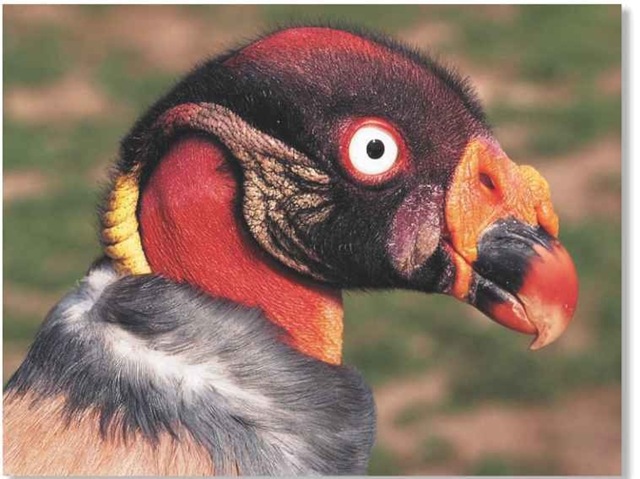ORDER
Falconiformes
FAMILY
Cathartidae
GENUS & SPECIES
key features
• A powerful scavenger that soars over the . forests of Central and South America
• One of the most strikingly colored and odd-looking of all birds of prey
• Often the first vulture to feed at a large carcass; its strong bill can rip through the toughest hide
where IN the world!
Ranges from central Mexico through Central America into South America, as far south as northern Argentina; also found 6n the island of Trinidad in the Caribbean

Lifecycle
The king vulture often relies on other vulture species to find a meal. But at a carcass, it lives up to its name when others stand back, giving way to the power of its mighty bill.
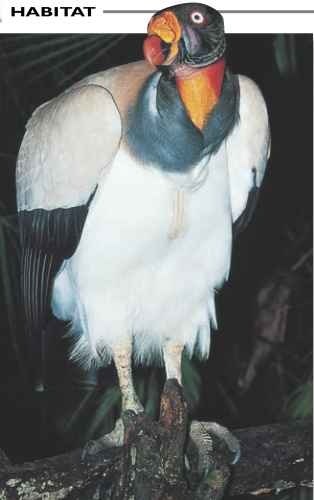
A Loner
The king vulture is at home in the deep gloom of dense rainforest.
The king vulture is a bird of the lowland tropics, but occasionally is found up to 8,250′ on the slopes of the Andes mountains. It prefers to fly over large, undisturbed areas of forest, but may hunt on open savannah and grassland, although usually only where there is woodland close by. It’s at home in the unbroken rainforests of the Amazon as well as in the dry, deciduous forests of parts of Central America, Venezuela, eastern Brazil, Paraguay, Bolivia and northern Argentina.
Food & feeding
The king vulture is a scavenger, feeding on carcasses of a wide range of wild and domestic animals. Soaring high, it uses its superb eyesight to spot carrion far below in grassland or forest clearings. But above dense forest, it relies on other vultures to guide it to food. Unlike the king vulture — and most other birds — the turkey vulture and two species of yellow-headed vulture, which share the king vulture’s range, have a keen sense of smell and use it while soaring at low level to trace carcasses other species can’t see.The king vulture takes advantage of this, often shadowing the smaller vultures. When they drop to feed, it follows close behind. It dominates the others at a carcass, but may tolerate their presence while it feeds.
The king vulture has a stronger bill than its relatives, and can even rip into the “armor” of an armadillo (above right). This sometimes benefits the smaller vultures as they can’t break into such carcasses themselves.
FIT FOR A KING
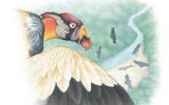
Search…
Soaring high, a king vulture spots turkey vultures below as they fly in circles — a sign that they’ve scented food hidden in the forest.
Breeding
Courtship begins in March with a pair of vultures opening and closing their wings and lowering their heads to show off their crowns.
Like other New World vultures, king vultures don’t build a nest. The female lays her one white egg in a hollow tree stump or on the ground, occasionally on cliffs, and sometimes in the old nests of other birds.The egg is incubated for 8 weeks, in some pairs by both sexes; in others, only by the female.The chick (covered in white down) and the female are fed on regurgitated carrion by the male. Later, the female helps feed her offspring.
The chick regularly wanders from the nest as it develops and fledges in three months.The parents keep a close watch on their young for possibly as long as two years, before it leaves and becomes independent.
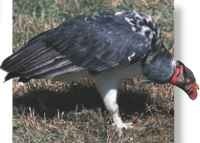
A Prince
This youngster has yet to grow full adult plumage.
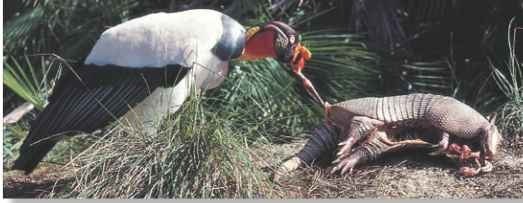
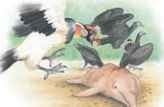
Follow…
The king vulture follows the turkey vultures to the carcass of a river dolphin that washed up on the bank and drives them away.
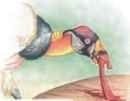
Tear…
The king vulture soon rips the dolphin open and begins feeding on the skin and tougher parts while the other vultures look on.

Full
When the king vulture has eaten its fill, the turkey vultures draw close, waiting to feed on the softer parts left behind.
CONSERVATION
It’s difficult to estimate the king vulture’s population, as the bird is rarely seen, spending much of its time in the forest canopy or soaring high in the sky. The species doesn’t appear to be threatened and may even benefit from the growing number of cattle ranches, provided it has access to patches of undisturbed forest for breeding. But it suffers when forests are cleared or where populations of large mammals are reduced.
Behavior
The king vulture isn’t very social and is usually found singly, in pairs or in family groups of two parents and a youngster. It spends its time soaring or perching on treetops or resting on river sandbanks. It’s a silent bird; along with its relatives, it lacks the syrinx (voicebox) of most birds and can make only weak hissing sounds.
The unusual pattern of brightly colored bare skin on the king vulture’s head probably helps it recognize members of its own species as well as advertise an individual’s status.

The king vulture’s species name, papa, is the Latin word for bishop and relates to the bird’s similar appearance to the finery worn by a bishop.
In Brazil, the turkey vulture — the frequent feeding partner of the king vulture — is called the minister vulture, reflecting its sometimes privileged, but subordinate, position.
Like its relatives the storks, the king vulture shoots its white, liquid droppings onto its legs to cool itself in hot weather.
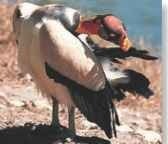
A Clean-shaven A featherless head is easy to clean after feeding.
Profile
King Vulture
A powerful build and intimidating bill enable the colorful king vulture to dominate other south American vultures and rip into tough carcasses.
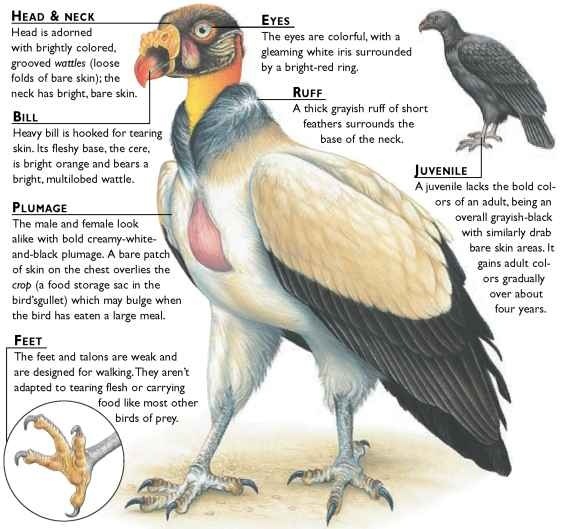
CREATURE COMPARISONS
Two other species of vulture from the New World are even larger than the king vulture: the California condor, Gymnogyps californianus,and Andean condor, Vultur gryphus.The latter is in the same family as the king vulture and is the world’s largest bird of prey.The Andean condor can be four times heavier than the king vulture; large males weigh up to 26 lbs. It has an overall length of up to 4′ and a wingspan of up to 10.5′. Like the king vulture, it has a bare neck to prevent soiling when feeding on carrion.The Andean s condor has also been known to kill sickly or dying animals.
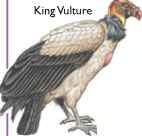

| vital | |
| statistics | |
| Weight | 6.5-8 lbs. |
| Length | 2-2.7′ |
| Wingspan | 6-6.5′ |
| Sexual Maturity | 3-4 years , |
| Mating Season | March-August |
| Number of Eggs | |
| Incubation I Period | 53-58 days |
| Fledging Period | About 3 months |
| . Breeding f Interval | 1 year |
| Typical Diet | Carrion of a wide variety of species |
| Lifespan | Unknown |
Related species
• The king vulture is one of 7 species of New World vulture in the Cathartidae family, which includes the American black vulture, California and Andean condors, the lesser and greater yellow-headed vultures and the turkey vulture. New World vultures, classified in the bird-of-prey order Falconiformes, are now thought to be more closely related to storks, family Ciconiidae, in the order Ciconiiformes.
